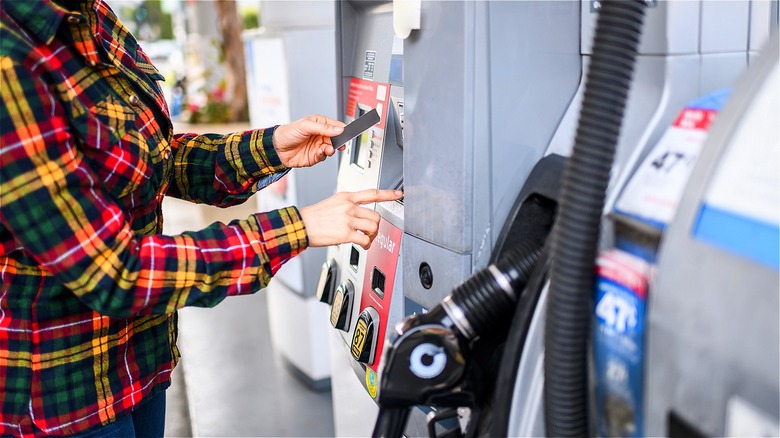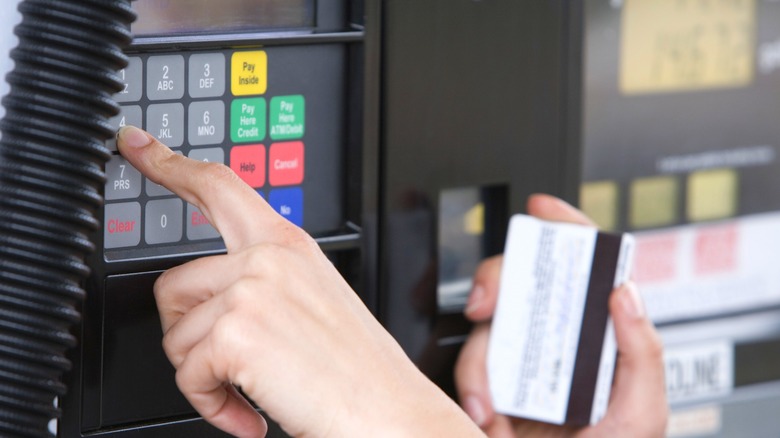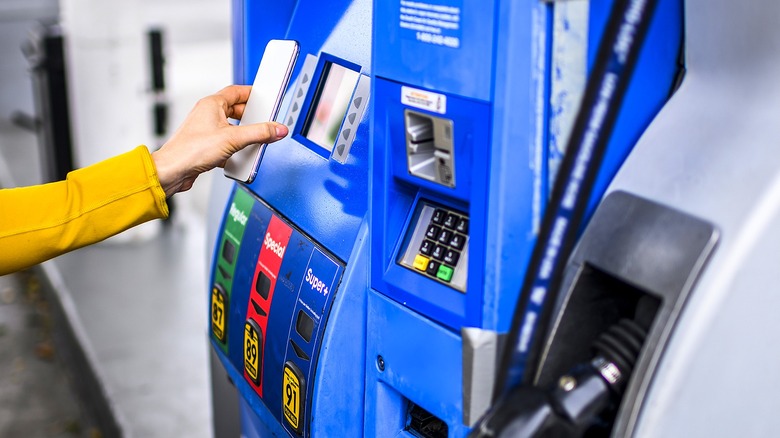Think Twice Before Using Your Debit Card To Pay For Gas. Here's Why
When you're on the go, paying for gas at the gasoline pump is a major convenience — and a major inconvenience if you have to actually go into the store to pay. However, if you're using a debit card, you may want to take a moment to do just that, to protect yourself from possible theft. Specifically, from skimming, a type of fraud that "skims" the data from a credit or debit card, and then flips that information for unauthorized use, such as for online or phone purchases.
Skimming has been around since the early 2000s, with thieves first installing card skimmers onto ATMs. The skimmers can even be installed on point-of-sale terminals, though this is more difficult to pull off. According to the FBI, card skimming theft accounts for an estimated $1 billion in losses a year. So, to protect your debit card from falling victim to this kind of theft, it's important you know how to protect yourself from skimming, including how to spot a skimmer at the gas pump.
How card skimmers read your debit card
Paying for gas at the pump with your debit card is fast and convenient, but it could cost you a lot more than a full tank, thanks to thieves who've been using (and perfecting) skimming scams for the past two decades. As said, card skimmers first surfaced in the 2000s, with thieves targeting ATMs specifically. As the FBI notes, card skimmers typically come in two parts: a skimming device that's attached to an ATM or payment terminal, like a gas pump's payment panel, and a hidden camera that captures a person's PIN when they punch it in. An alternative is a phony keypad that can record a person's PIN combination.
By 2013, card skimming had expanded in scope, beyond automatic tellers, making its way to gas station kiosks as well. And when gas stations made the switch to chip technology a few years back, scammers adjusted to this development, too, introducing "shimmers," which are installed inside of card readers to steal your data directly from the chips. As you can imagine, because shimmers are inside of card readers, it can be even more difficult to detect their presence.
Protecting your debit card from skimming
Note that debit cards aren't protected from unauthorized use in the way credit cards are; in fact, per the Electronic Fund Transfer Act, you could be held liable for up to $50 of fraudulent transactions, depending on when you report a lost or stolen debit card. With this said, stolen data, like in the case of skimming, grants you a bit more time. In such cases, you have 60 days to report your debit card number has been compromised, starting from the date of the statement in which you first notice any unauthorized use.
So, in short, it's up to you to protect your debit card. And you certainly can still use your card to pay for gas, but just be cognizant of possible skimming (or shimming) activity. That is, observe the entire payment panel: Is anything loose or crooked? Does it look to be tampered with? Are there scratches? Is there any tape residue? These are all signs the payment station may have been compromised, and you should go inside to pay for your gas, to be safe.
If you do use your debit card to pay for gas at a kiosk, take the precaution of blocking the keypad with your hand when you're entering your PIN. Or, rather, don't input your PIN at all, by selecting "Credit" instead. This will allow you to bypass entering your PIN code. Further, many cards today are contactless, allowing you to tap to pay. If your debit card is so equipped, opt for this method; or, add your debit card to your phone's digital wallet, such as Samsung Pay or Apple Pay, and pay for your gas like this.


